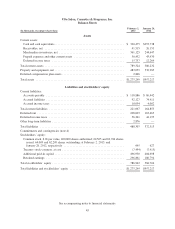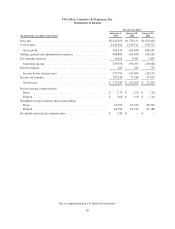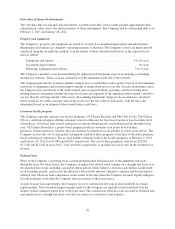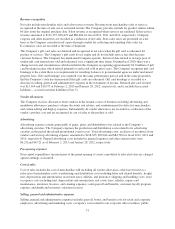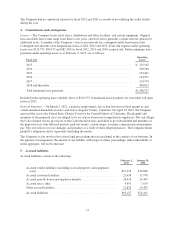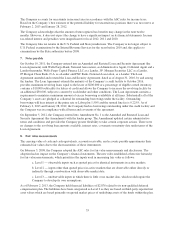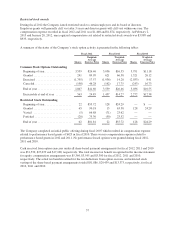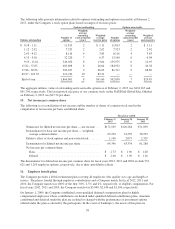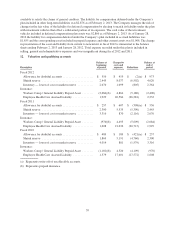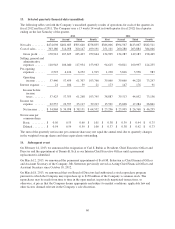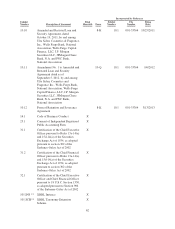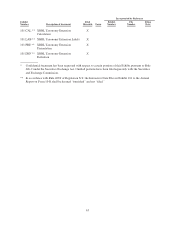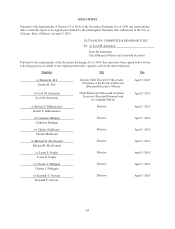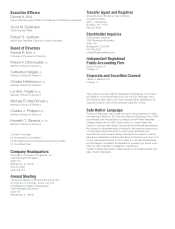Ulta 2012 Annual Report Download - page 59
Download and view the complete annual report
Please find page 59 of the 2012 Ulta annual report below. You can navigate through the pages in the report by either clicking on the pages listed below, or by using the keyword search tool below to find specific information within the annual report.The Company accounts for uncertainty in income taxes in accordance with the ASC rules for income taxes.
Based on the Company’s best estimate of the potential liability for uncertain tax positions there was no reserve at
February 2, 2013 and January 28, 2012.
The Company acknowledges that the amount of unrecognized tax benefits may change in the next twelve
months. However, it does not expect the change to have a significant impact on its financial statements. Income
tax-related interest and penalties were insignificant for fiscal 2012, 2011 and 2010.
The Company files tax returns in the U.S. Federal and State jurisdictions. The Company is no longer subject to
U.S. Federal examinations by the Internal Revenue Services for the years before 2010 and, this applies to
examinations by the State authorities before 2008.
7. Notes payable
On October 19, 2011, the Company entered into an Amended and Restated Loan and Security Agreement (the
Loan Agreement) with Wells Fargo Bank, National Association, as Administrative Agent, Collateral Agent and a
Lender thereunder, Wells Fargo Capital Finance LLC as a Lender, J.P. Morgan Securities LLC as a Lender,
JP Morgan Chase Bank, N.A. as a Lender and PNC Bank, National Association, as a Lender. The Loan
Agreement amended and restated the Loan and Security Agreement, dated as of August 31, 2010, by and among
the lenders. The Loan Agreement extends the maturity of the Company’s credit facility to October 2016,
provides maximum revolving loans equal to the lesser of $200,000 or a percentage of eligible owned inventory,
contains a $10,000 subfacility for letters of credit and allows the Company to increase the revolving facility by
an additional $50,000, subject to consent by each lender and other conditions. The Loan Agreement contains a
requirement to maintain a minimum amount of excess borrowing availability at all times. Substantially all of the
Company’s assets are pledged as collateral for outstanding borrowings under the facility. Outstanding
borrowings will bear interest at the prime rate or Libor plus 1.50% and the unused line fee is 0.225%. As of
February 2, 2013 and January 28, 2012, the Company had no borrowings outstanding under the credit facility and
the Company was in compliance with all terms and covenants of the agreement.
On September 5, 2012, the Company entered into Amendment No. 1 to the Amended and Restated Loan and
Security Agreement (the Amendment) with the lender group. The Amendment updated certain administrative
terms and conditions and provides the Company greater flexibility to take certain corporate actions. There were
no changes to the revolving loan amounts available, interest rates, covenants or maturity date under terms of the
Loan Agreement.
8. Fair value measurements
The carrying value of cash and cash equivalents, accounts receivable, and accounts payable approximates their
estimated fair values due to the short maturities of these instruments.
On February 3, 2008, the Company adopted the ASC rules for fair value measurements and disclosures. The
adoption had no impact on the Company’s financial statements. The new rules established a three-tier hierarchy
for fair value measurements, which prioritizes the inputs used in measuring fair value as follows:
a. Level 1 — observable inputs such as quoted prices for identical instruments in active markets.
b. Level 2 — inputs other than quoted prices in active markets that are observable either directly or
indirectly through corroboration with observable market data.
c. Level 3 — unobservable inputs in which there is little or no market data, which would require the
Company to develop its own assumptions.
As of February 2, 2013, the Company held financial liabilities of $2,876 related to its non-qualified deferred
compensation plan. The liabilities have been categorized as Level 2 as they are based on third-party reported net
asset values which are based primarily on quoted market prices of underlying assets of the funds within the plan.
55


